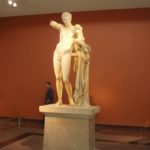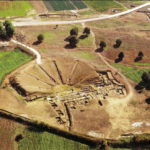Katakolon is a small beautiful seaside village full of natural beauty. By visiting Katakolon you will discover and will admire the magic of nature in such a small location.Visit the harbor which used by the cruise ships carrying passengers to visit the ancient Olympia, enjoy your drink or lunch by the sea, discover the streets filled with souvenir shops, walk in the tree-lined mountain and enjoy the lovely overlooking of the Ionian Sea.
As long as you’re here, we recommend you to visit the Church of St. Nicholas, the lighthouse of Katakolo and the castle of Katakolo named “Pontikokastro” among with the following places in the area:
Ancient Olympia Archaeological Site and Museum (The Birthplace of the Olympic Games)
 In western Peloponnese, lies the most celebrated sanctuary of ancient Greece.
In western Peloponnese, lies the most celebrated sanctuary of ancient Greece.
Olympia, was the site of the ancient Olympic Games, which were celebrated every four years by the Greeks.
Dedicated to Zeus, the father of the gods, set in a valley between two rivers, Alpheios and the Kladeos and over the southwest foot of Mount Kronios is one of the most popular and famous sites in Greece.
The modern village of Olympia, is a collection of tourist shops, cafes, restaurants and of course the Historical Museum of the Olympic Games.
You can visit Ancient Ilida by using your own or rental vehicle (about 40min / 40km).
Temple of Apollo Epicurius
 The Temple of Apollo Epicurius at Bassae was an Ancient Greek temple known for its architecture. The temple was built from 420 to 400 BC probably from Iktinos, the architect of Parthenon, and it was dedicated by the residents to the god of healing Apollo Epicurius.
The Temple of Apollo Epicurius at Bassae was an Ancient Greek temple known for its architecture. The temple was built from 420 to 400 BC probably from Iktinos, the architect of Parthenon, and it was dedicated by the residents to the god of healing Apollo Epicurius.Katakolo – Temple of Apollo Epicurius, Google map
Chlemoutsi Castle or Castle of Kyllini
 Chlemoutsi Castle was founded in 1220-1223 by Geoffrey Villehardouin prince and is located near Katakolon (about 35 minutes by car) and was the most important castle of the Princedom of Achaia.
Chlemoutsi Castle was founded in 1220-1223 by Geoffrey Villehardouin prince and is located near Katakolon (about 35 minutes by car) and was the most important castle of the Princedom of Achaia.Kyllini Thermal Baths
Agios Nikolaos (St. Nicholas) church at Katakolon
 Agios Nikolaos, or St Nicholas in Greece, is the protector saint of Katakolo village and and its residents have dedicated a temple worth visiting.
Agios Nikolaos, or St Nicholas in Greece, is the protector saint of Katakolo village and and its residents have dedicated a temple worth visiting.
Museum of Ancient Greek Technology in Katakolon
 The Museum of Ancient Greek technology in Katakolo operates under the auspices of the Municipality of Pyrgos and includes approximately 200 reliably operating models of mechanisms and inventions of the ancient Greek wonder after research, study and construction by Kostas Kotsanas. It is the most reliable and plenary exhibition of its kind in the world.
The Museum of Ancient Greek technology in Katakolo operates under the auspices of the Municipality of Pyrgos and includes approximately 200 reliably operating models of mechanisms and inventions of the ancient Greek wonder after research, study and construction by Kostas Kotsanas. It is the most reliable and plenary exhibition of its kind in the world.
Museum of Ancient Greek Musical Instruments & Toys in Katakolon
 The Museum of Ancient Greek Musical Instruments and Toys & Games operates in Katakolon, under the auspices of the Municipality of Pyrgos, in the John S. Latsis building next to the Museum of Ancient Greek Technology and includes 42 ancient Greek musical instruments accompanied by detailed descriptions and diagrams after research, study and construction by Kostas Kotsanas. The instruments operate and their construction is based on ancient Greek literature and vase paintings.
The Museum of Ancient Greek Musical Instruments and Toys & Games operates in Katakolon, under the auspices of the Municipality of Pyrgos, in the John S. Latsis building next to the Museum of Ancient Greek Technology and includes 42 ancient Greek musical instruments accompanied by detailed descriptions and diagrams after research, study and construction by Kostas Kotsanas. The instruments operate and their construction is based on ancient Greek literature and vase paintings.



